- CPV
- EMC
- [QC on FLP - plot integrated over the run] Payload Size/events
- [QC on FLP - plot integrated over the run] Bunch minimum amplitude EMCAL+DCAL
- [QC on EPN - plot integrated over the run] Cell Occupancy plots (PHYS) for E>0.2 GeV and E<0.2 GeV
- [QC on EPN - plot integrated over the run] Cell Amplitude
- [QC on EPN - plot integrated over the run] Digit Time
- Known issues
- FDD
- FT0
- FV0
- HMP
- ITS
- ITS KNOWN ISSUES
- MCH
- MFT
- MID
- PHS
- TOF
- TPC
- TRD
CPV#
Synthetic runs#
Monitor if plots are not empty and timestamps are updated.
If you see "Number of entries has not changed in the past cycle" but run is still ongoing inform the oncall.
[QC on EPN] Digit Map in M2,3,4#
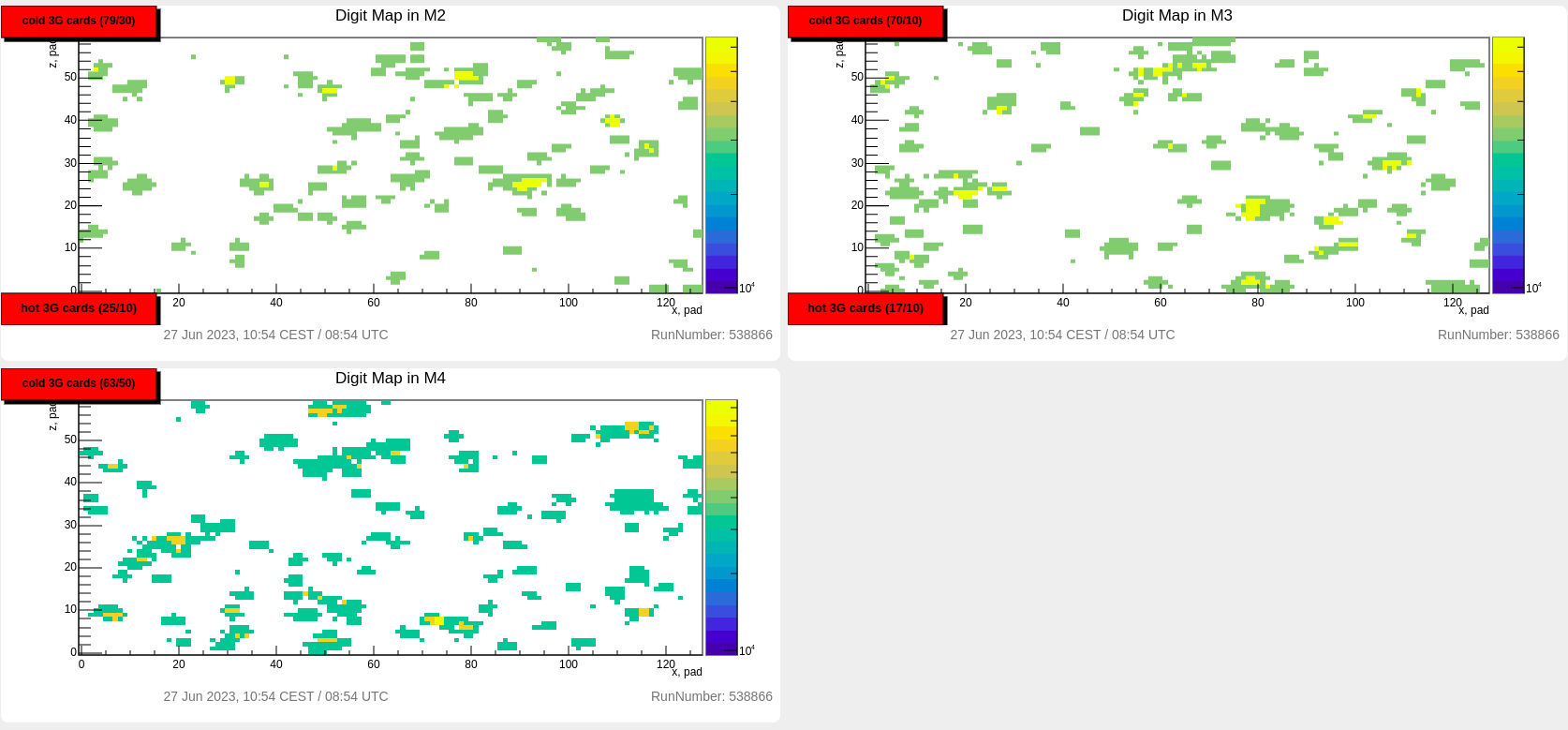 The plots represent number of digits seen in each channel.
Note that in SYNTHETIC runs the Digit Maps can be rather sparse because of little statistics replayed from MC simulated data.
The plots represent number of digits seen in each channel.
Note that in SYNTHETIC runs the Digit Maps can be rather sparse because of little statistics replayed from MC simulated data.
Ignore any red messages except "Number of entries has not changed in the past cycle".
[QC on EPN] Errors occurance#

The plot shows decoder error occurance per event.
There are 2 types of synthetic runs:
- Data replay as input for synthetic loop. Please inform oncall in case when plot is not OK.
- MC events as input for synthetic loop. For such runs no decoder errors are expected. If plot is not empty please inform the on-call. Bad example: errors present but message is "Ok"
Please ask SL or RM if run type is data replay or MC simulted.
Minimal duration after SOR before taking any action required by these instructions: 5 min
Known issues#
-
In PEDESTAL runs QC plot "Pedestal sigma distribution M3 is bad". Acording to expert, noise conditions in CPV depend on general environment in ALICE, therefore, from time to time CPV pedestals can become wider which is reflected in QC-CPV calibration run plot with the message "Number of bad pedestal sigmas in module M3 (sometimes in M2) is larger than the upper limit". This is a known issue, can be ignored, but make a log entry when it happens. See: https://ali-bookkeeping.cern.ch/?page=log-detail&id=45015
-
In PHYSICS runs Red messages on QC Plot "Digit Map in M4". Problem with high voltage is preventing this module from running normally. Experts are trying to recover. No need to report. Run quality must be setted to "good" if there are no problems with other modules. See: https://ali-bookkeeping.cern.ch/?page=log-detail&id=53523. Quality aggregator is also expected to show bad quality for
Digit oocupancy checkandCalibDigit amplitude check.
EMC#
Don't call EMC expert during the night if run is not physics
[QC on FLP - plot integrated over the run] Payload Size/events#
| good quality | bad quality | empty |
|---|---|---|
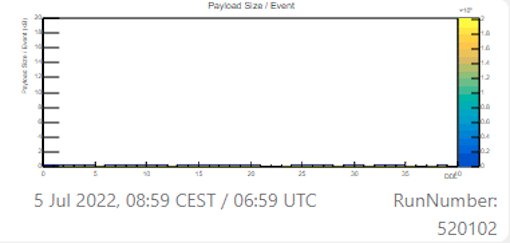 |
 |
 |
- If "Data OK" is shown, everything is fine.
- If some of the DDL presents entries that are larger than the others, a red message will appears: please call EMCAL oncall.
- If the plot is empty, and EMCAL is included in the data taking, call EMCAL oncall.
[QC on FLP - plot integrated over the run] Bunch minimum amplitude EMCAL+DCAL#
| good quality | bad quality |
|---|---|
 |
 |
- One peak should be visibile for all supermodules around 0 if EMCAL is in data taking.
- If the peak moves to the range 20-50 "Min raw amplitude (ADC)" for any supermodule, or a second peak appears for any supermodule in that range , call EMCAL oncall
- If the plot is empty, and EMCAL is included in the data taking: please call EMCAL oncall
[QC on EPN - plot integrated over the run] Cell Occupancy plots (PHYS) for E>0.2 GeV and E<0.2 GeV#
| good quality | good quality | bad quality |
|---|---|---|
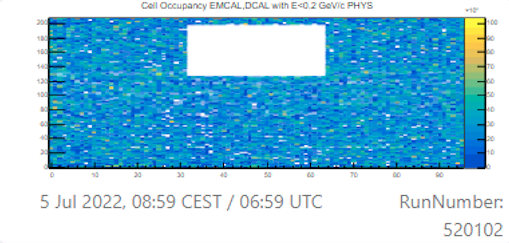 |
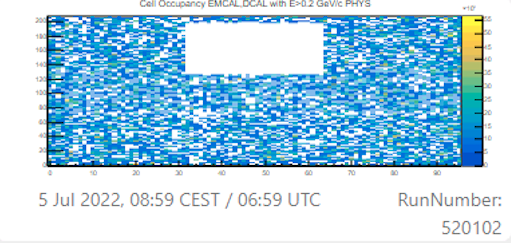 |
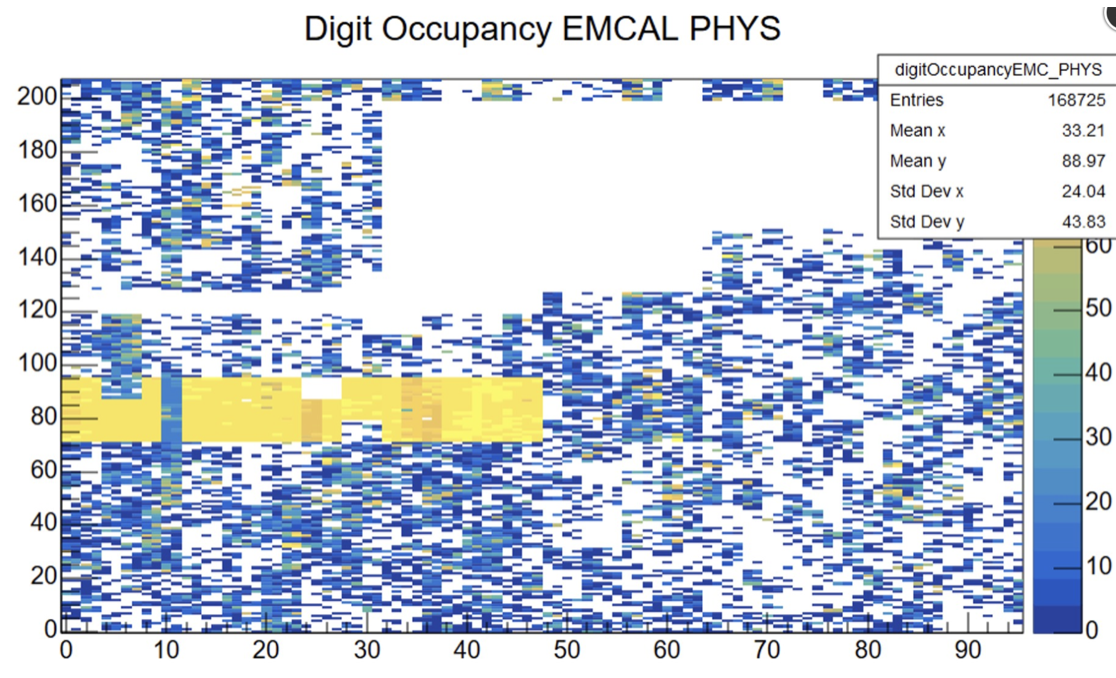 |
- The occupancy plots should be uniformly filled.
- if something noisy appears, please call the EMCAL oncall.
- If the plot is empty, and EMCAL is included in the data taking, call EMCAL oncall.
[QC on EPN - plot integrated over the run] Cell Amplitude#
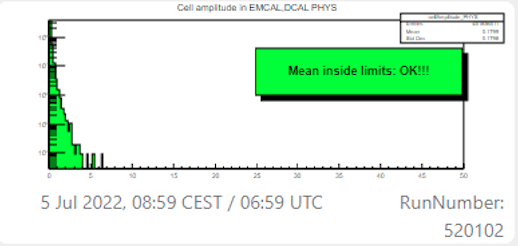
- If the plot is empty, and EMCAL is included in the data taking, call EMCAL oncall.
[QC on EPN - plot integrated over the run] Digit Time#
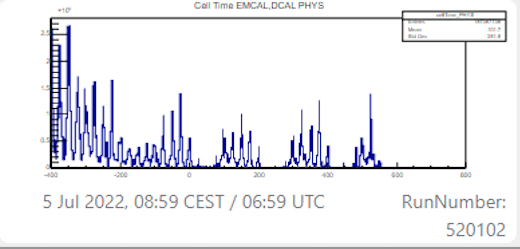
- if the peaks are not present, call EMCAL oncall.
- If the plot is empty, and EMCAL is included in the data taking, call EMCAL oncall.
Known issues#
-
Do not call EMC oncall during the night for QC plots related errors for non PHYSICS runs, unless a PHYSICS run is expected next.
-
An empty region is expected near the bottom-right corner for CAL (Calibration) triggers.
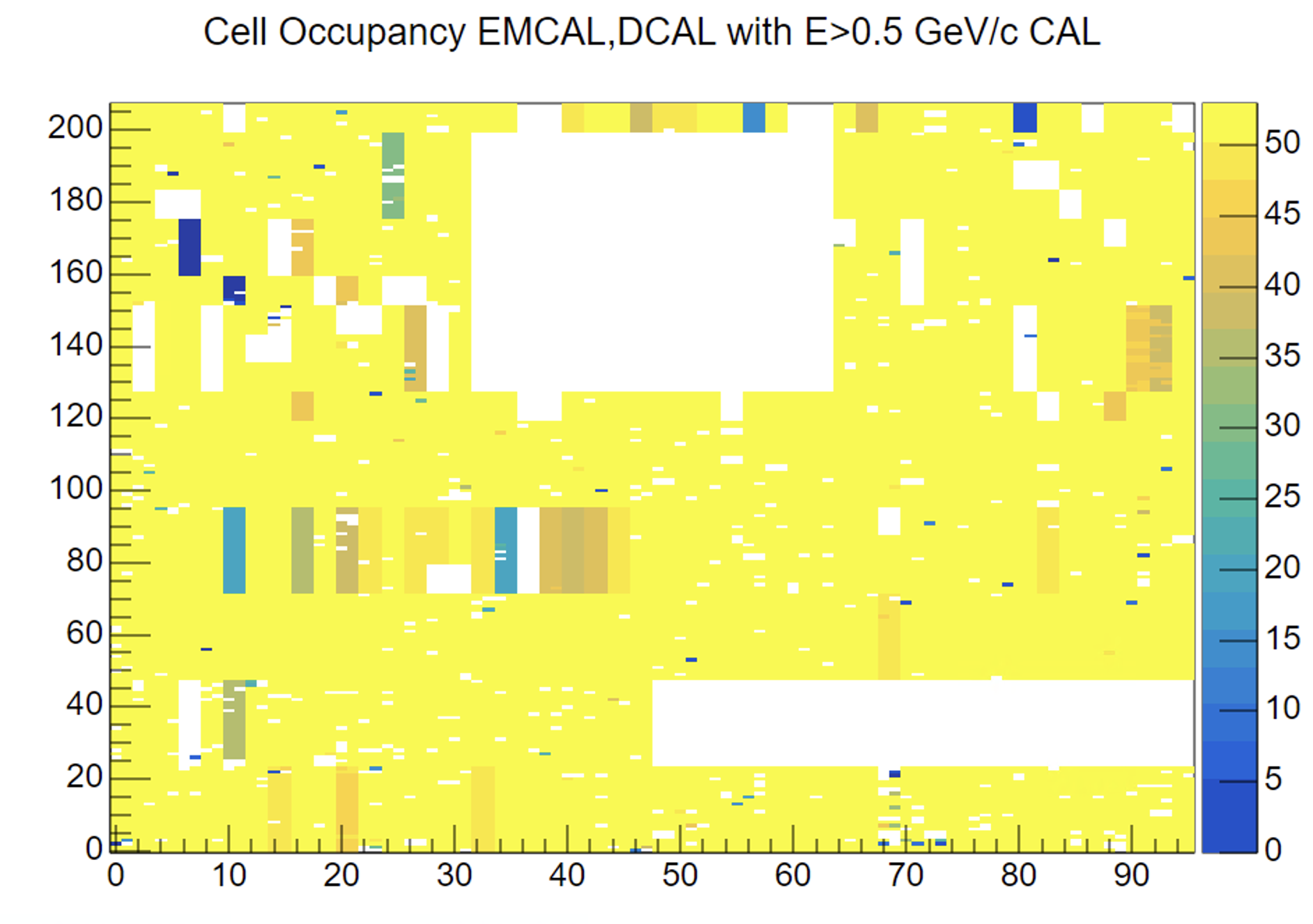
FDD#
FDD: General#
All QC plots are generated in 5 min. cycles. The histogram contents are reseted after each cycle. Please wait at least 5 min. from the start of the RUN to judge about the quality of collected data.
If a non-critical (i.e. expendable) QC task fails, please add a bookkeeping entry about it.
FDD: Out of bunch collisions#
[QC on EPN/QC nodes - plot integrated over the QC cycle]

BC vs trigger correlation for the events which were detected but are not aligned (out-of-bunch) with LHC filling scheme. The number of out-of-bunch events depends on the trigger settings.
Actions:
- No actions at the moment. See known issues.
FDD: Fraction of events with CFD in ADC gate#
[QC on EPN/QC nodes - plot integrated over the QC cycle]
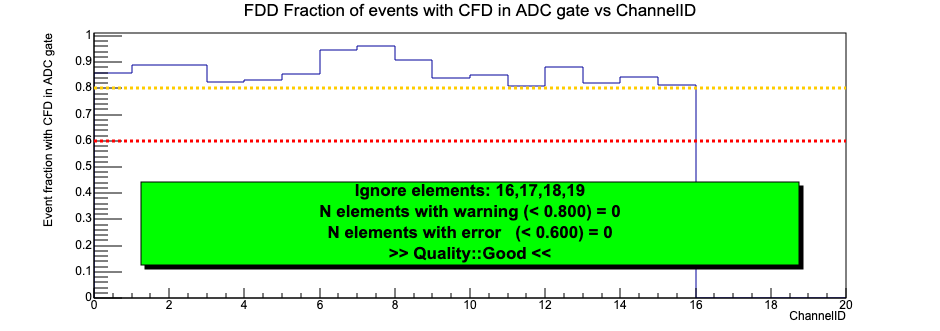
Efficiency for getting charge information in each detector channel. Horizontal lines show the levels below which the warnings/errors are raised.
Actions:
- If ERROR/WARNING - make a bookkeeping entry.
Known issues#
- The Out of bunch collisions plot can be ignored in SYNTHETIC runs at the moment (i.e. no need to take any actions in case of not GOOD quality). The BC distribution is not simulated properly in MC and will always cause problems in this plot.
FT0#
FT0: General#
All QC plots are generated in 5 min. cycles. The histogram contents are reseted after each cycle. Please wait at least 10 min. from the start of the RUN to judge about the quality of collected data.
If a non-critical (i.e. expendable) QC task fails, please add a bookkeeping entry about it.
FT0: Out of bunch collisions#
[QC on EPN/QC nodes - plot integrated over the QC cycle]

BC vs trigger correlation for the events which were detected but are not aligned (out-of-bunch) with LHC filling scheme. The number of out-of-bunch events depends on the trigger settings. For the Vertex trigger should be almost ZERO counts.
Actions:
- If ERROR/WARNING - make a bookkeeping entry.
FT0: CFD efficiency#
[QC on EPN/QC nodes - plot integrated over the QC cycle]
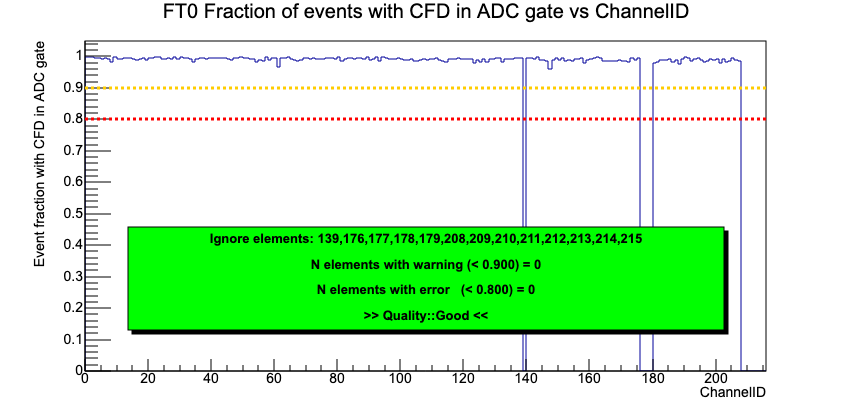
Efficiency for getting charge information in each detector channel. Horizontal lines show the levels below which the warnings/errors are raised.
Actions:
- If ERROR/WARNING - make a bookkeeping entry.
Known issues#
- channels 60-63 (FT0A side) are OFF in PHYSICS and COSMICS runs
- channels 139 and 176-179 (FT0C side) are OFF in PHYSICS and COSMICS runs
FV0#
FV0: General#
All QC plots are generated in 5 min. cycles. The histogram contents are reseted after each cycle. Please wait at least 10 min. from the start of the RUN to judge about the quality of collected data.
If a non-critical (i.e. expendable) QC task fails, please add a bookkeeping entry about it.
FV0: Out of bunch collisions#
[QC on EPN/QC nodes - plot integrated over the QC cycle]

BC vs trigger correlation for the events which were detected but are not aligned (out-of-bunch) with LHC filling scheme. The number of out-of-bunch events depends on the trigger settings. The check is performed for the TrgNchan trigger.
Actions:
- If ERROR/WARNING - make a bookkeeping entry.
FV0: Fraction of events with CFD in ADC gate#
[QC on EPN/QC nodes - plot integrated over the QC cycle]
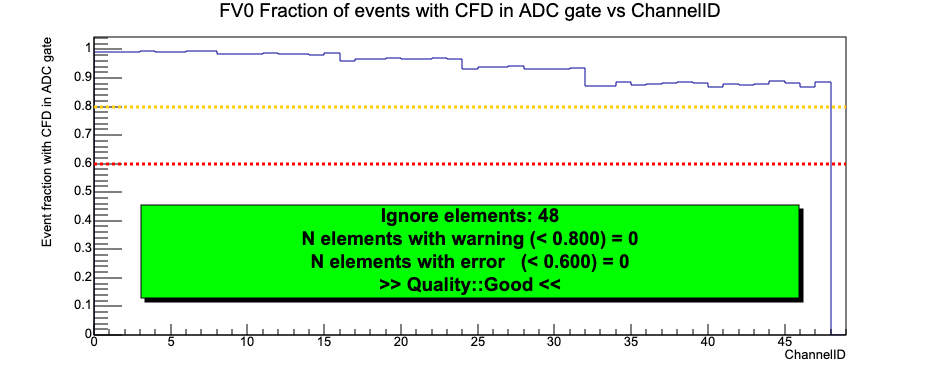
Efficiency for getting charge information in each detector channel. Horizontal lines show the levels below which the warnings/errors are raised.
Actions:
- If ERROR/WARNING - make a bookkeeping entry.
Known issues#
HMP#
Busy time#
[QC on FLP]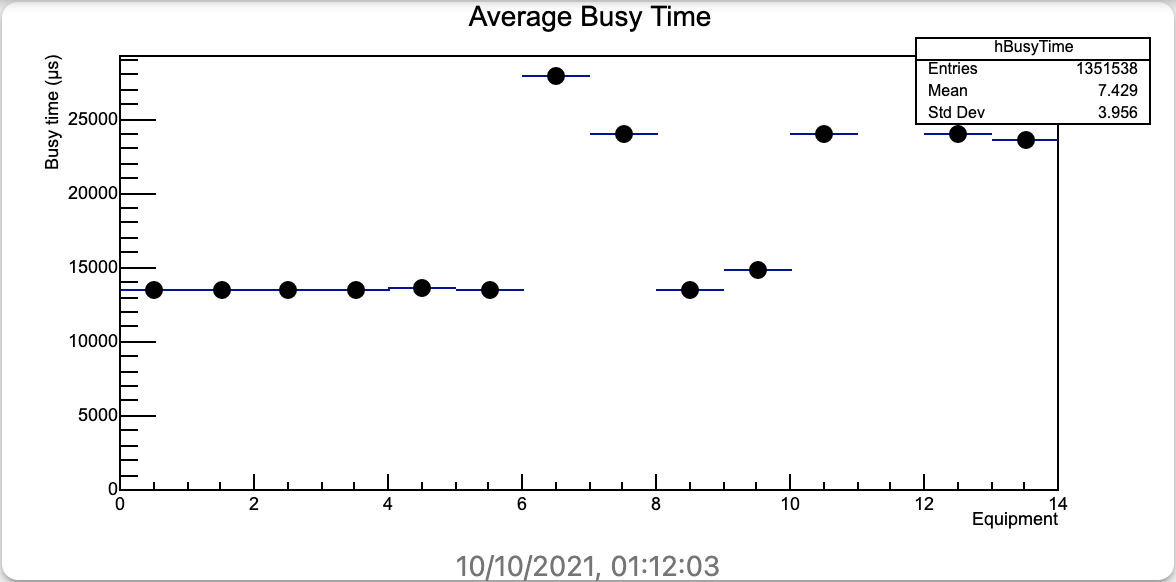
The plot shows the busy time of the detector.
Event size#
[QC on FLP]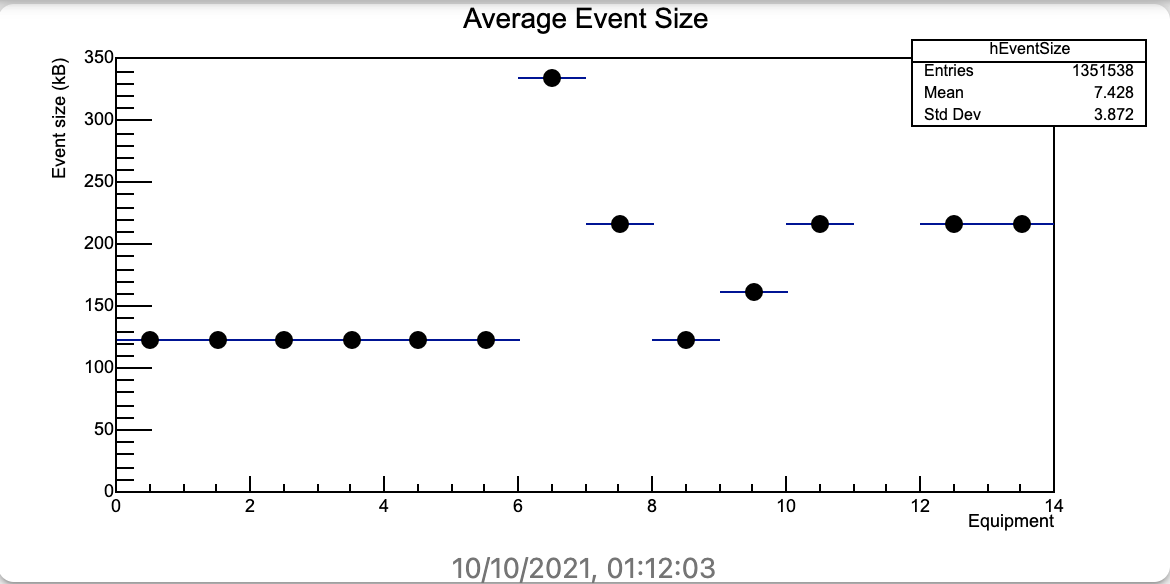
The plot shows the event size of the detector.
Sum Q maps#
[QC on FLP]
The plot shows the charge of all the detector channels in only one 2D map. It looks like the example plot shown above. In case it is completely empty call HMP on-call.
Charge vs HV sector#
[QC on FLP]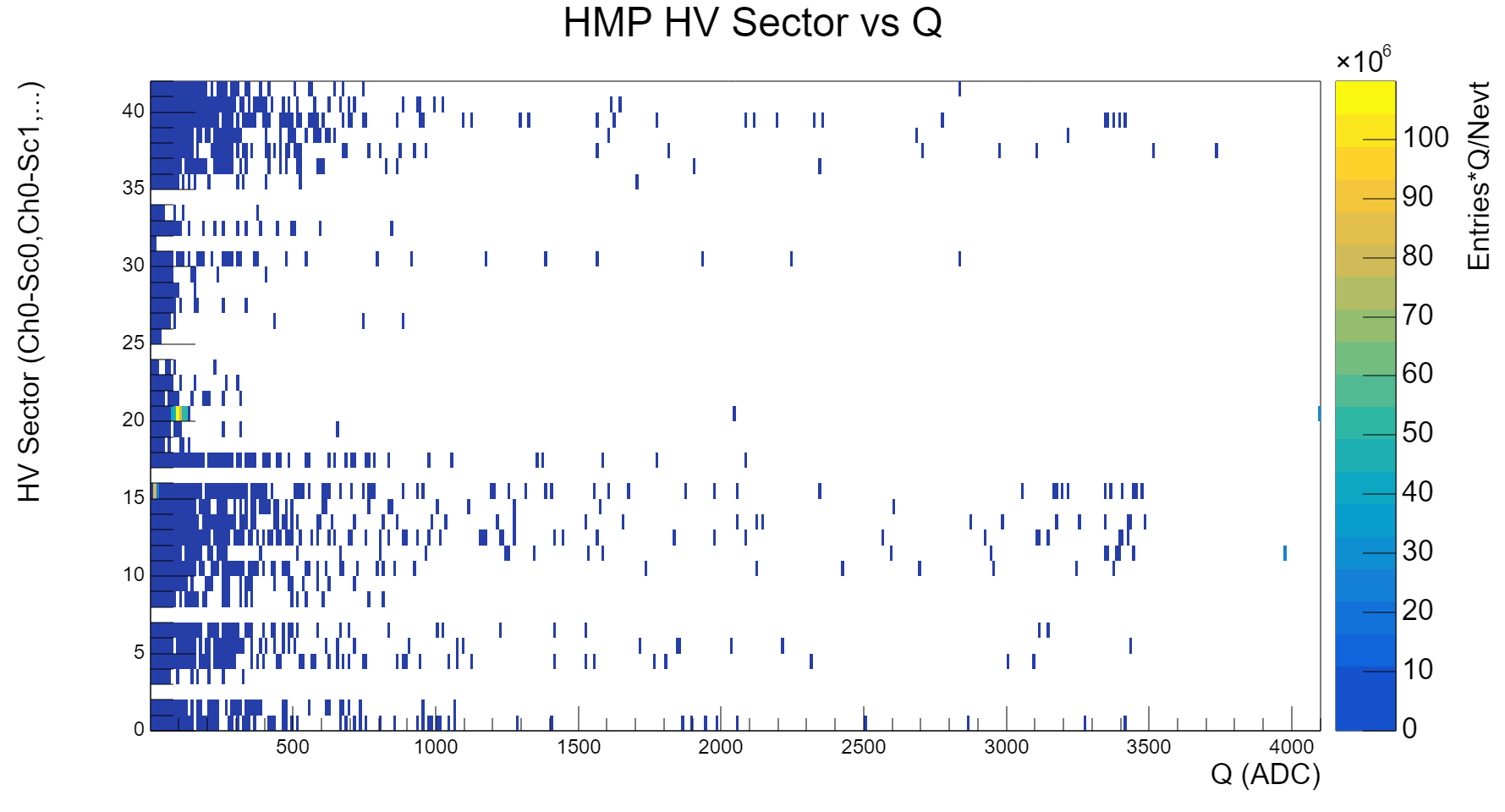
The plot shows the charge of all the detector HV sectors in only one 2D map. It looks like the example plot shown above. The white bands correspond to the faulty HV sectors that are off. In case more than two bands (w.r.t those shown here) became white call the an-call.
Occupancy#
[QC on FLP]
The plot shows the occupancy for each detector DDL. In case more than three equipments exceeds 3% or the plot is empty call HMP on-call
Known issues#
For the moment links 3 and 12, exlcuded from data taking
ITS#
General considerations#
If any of the plots listed on this page remains empty during a run or its timestamp and run number are not up to date, please call the ITS on-call.
Error count vs Error id#
[QC on FLP]
The total number of decoding errors (the error ID is on the x-axis). The left figure provides an example of a good case, while the right corresponds to run with BAD quality;
The BAD quality flag will be triggered when a number of decoding errors exceed some limit; MEDIUM quality corresponds to the case when the number of errors is non-zero, but not significant for the BAD run. The following quality messages can be printed on the plot:
- Quality::GOOD
- Quality:: BAD: "definition of error ID"
- Quality:: MEDIUM: "definition of error ID"
If the number of error with a certain ID show a BAD quality message, call the ITS on-call. In case of the MEDIUM quality, create a log entry linked to run and with tag = ITS.
Please ignore the last bin of this plot. The increase of counts there should be neglected.
Trigger count vs TriggerID and FeeID#
[QC on FLP] Plot summarizing trigger flags. The X-axis corresponds to the ID of Front-End Electronic; the Y-axis shows the list of all possible triggers that can be received by FEE. The coloured scale represents the counts in each bin. During physical run, we expect that all FEEs receive HB, ORBIT, SOC and TF trigger signals. The GOOD run is shown on the left panel, while the problematic one is depicted on the right. QC can plot the following error messages:
Plot summarizing trigger flags. The X-axis corresponds to the ID of Front-End Electronic; the Y-axis shows the list of all possible triggers that can be received by FEE. The coloured scale represents the counts in each bin. During physical run, we expect that all FEEs receive HB, ORBIT, SOC and TF trigger signals. The GOOD run is shown on the left panel, while the problematic one is depicted on the right. QC can plot the following error messages:
- Quality::GOOD
- Quality:: BAD: Trigger flag (TRIGGER_NAME) of bad quality
call the ITS on-call in the case of BAD quality messages and also in the following cases:
- there are x-bins without entries (i.e., vertical white lines on the plot)
- entries are present in the empty lines in the example plot above.
- the plot is completely empty
Ignore the quality message about the SOC trigger for the SYTH run type
Cluster Occupancy overview#
[QC on EPN]
Overview of the cluster occupancy, i.e. clusters per event, for each stave (1 bin in the plot). Good example for current synthetic pp (left) and synthetic Pb-Pb (right) are provided. Note the different order of magniture for the z axis. Check the general trend, i.e. occupancy decreasing when going from the innermost to the outermost layers. QC provides the following quality messages for this plot:
- Quality:: MEDIUM: Layer_Stave has large cluster occupancy
- Quality:: BAD: Layer_Stave has empty stave
In particular, in synthetic runs you will see messages about larger cluster occupancy in different layers.
call the ITS on-call if the plot is different from example.
Angular Distribution#
[QC on EPN]
Angular distribution: phi vs eta (2D plot) of online reconstructed tracks. Example of GOOD plots for synthetic pp (left) and synthetic Pb-Pb (right), no action needed in this case.
Possible Quality messages that can appear on the plot during a run:
- Quality::GOOD
- BAD: Asymmetric Phi distribution (OK if there are disabled ITS sectors)
- BAD: Asymmetric Eta distribution (OK if there are disabled ITS sectors)
- BAD: NO ITS TRACKS
Please call the ITS on-call if plots look much different from example.
Number of clusters per track#
[QC on EPN]
Distribution of the number of clusters per track. The plot shows a GOOD and BAD example of a synthetic run for both pp and Pb-Pb collisions. The following messages can appear:
- Quality::GOOD
- Quality::Medium Mean is outside 5.2-6.2, ignore for COSMICS and TECHNICALS
- Quality::BAD: 0 tracks with 4/5/6/7 clusters (OK if it's synthetic run)
- Quality::BAD: NO ITS TRACKS
call the ITS on-call if a completely different plot is obtained, if the quality is BAD, or if the plot stays empty after 5 min of data taking.
Known issues#
ITS KNOWN ISSUES#
MCH#
Quality Summary#
[QC on EPN]
The left panel shows a summary of the automated checked on the MCH data, in a human-readable format. The top line describes the aggregated quality status, followed by a message suggesting the appropriate action according to the quality level:
-
Bad: immediately inform the MCH on-call
-
Medium: write a logbook entry, tagging MCH
-
Null: the plots are completely empty. Check in DCS if MCH is in STANBY. If not, inform the MCH on-call.
The right panel shows a trending plot of the aggregated quality. The message in the left panel always corresponds to the most recent point in the trending plot.
If the quality in the trend plot is Bad for the whole duration of a run, MCH should be marked as Bad in the Bookkeeping flags for the run.
Quality Plots#
The following plots show the distribution of various estimators of the MCH data quality. Each horizontal bin shows the value of the monitored quantity, averaged over one Detection Element(DE). The vertical dashed lines show the boundaries between each of the 10 MCH chambers. An horizontal dashed line shows the threshold used by the checker to decide if a given detection element is considered good or bad.
The checker assigns an overall Good (green), Medium (orange) or Bad (red) quality flag to the plot, depending on the number and pattern of bad DEs. In general, the quality is still considered Good if only few DEs are bad. The quality is set to Medium if several DEs are Bad, but no significant impact on the detector acceptance is expected. If the number and pattern of bad DEs is such that the acceptance will be degraded, the quality is set to Bad.
The overall aggregated MCH quality is the logic AND of the qualities of the individual plots.
Fraction of Synchronized Boards#
[QC on EPN]
The plot shows, for each Detection Element, the fraction of FEC boards that are properly synchronized. A given DE is coinsidered bad if the corresponding fraction is below the horizontal dashed line.
Fraction of Boards not in Error#
[QC on EPN]
The plot shows, for each Detection Element, the fraction of FEC boards that do not have decoding errors. A given DE is coinsidered bad if the corresponding fraction is below the horizontal dashed line.
Fraction of Boards with Good Rate#
[QC on EPN]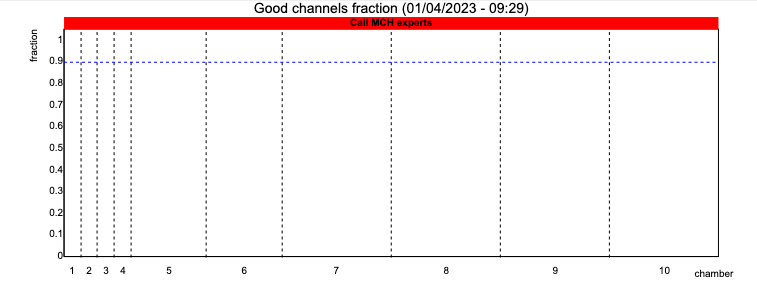
The plot shows, for each Detection Element, the fraction of FEC boards that have a correct hit rate. A given DE is coinsidered bad if the corresponding fraction is below the horizontal dashed line.
Average Hit Rate#
[QC on EPN]
The plot shows the average hit rate (in kHz) for each detection element. A given DE is coinsidered bad if the corresponding rate is below the horizontal dashed line.
Average Pseudo-efficiency#
[QC on EPN]
The plot shows the average pseudo-efficiency for each detection element. The detection efficiency is estimated from the correlation between the pre-clusters reconstructed in either cathode of each DE. A given DE is coinsidered bad if the corresponding efficiency is below the horizontal dashed line.
Known issues#
-
In SYNTHETIC runs, MCH global quality may depend on the replay configuration
- in p-p replay (500 kHz) : MCH run global quality is expected to be good. If quality is bad or medium, notify the on-call via a logbook entry
- in PbPb replay : MCH run global quality is expected to be good. If quality is bad or medium, notify the on-call via a logbook entry
- in OO replay (oo-35khz-synt-8tf) : MCH run global quality is expected to be bad (Precluster and tracks quality : bad). No need to notify the on-call via a logbook entry.
- other replay settings : MCH run global quality may oscillates between good and bad. If quality is bad or medium, notify the on-call via a logbook entry
-
In TECHNICAL runs, MCH global quality depends on the DCS state of MCH
- if MCH state is READY : MCH global quality should be good. If MCH global quality is bad a notification via a logbook entry is enough.
- if MCH state is BEAM_TUNING (BEAM_TU) or STANDBY_CONFIGURED (STDB_CO): MCH global quality is expected to be bad. Only the "Decoding errors" is expected to have a good quality; if this is not the case a notification via a logbook entry is enough.
-
In COSMICS runs, the low number of tracks makes it difficult to compute the efficiency for all detection elements in each cycle. Hence oscillations between good and bad status should be expected.
- if Bad Preclusters quality: Bad Mean Efficiency vs DE(B) and Mean Efficiency vs DE(NB) show multiple bins below threshold value. This is a known issue, no need to notify.
- if the global quality is bad continuously for more than 1 hour, please make a notification via a logbook entry.
-
FLP Infologger
- QC plots have been disabled and will generate some errors about not-found plots that can be ignored, for instance :
- Requested resource does not exist: ali-qcdb.cern.ch:8083/qc/MCH/QO/DecodingCheck/1709911754085/PeriodName=LHC24aa/RunNumber=548050/
- Requested resource does not exist: ali-qcdb.cern.ch:8083/qc/MCH/QO/PreclustersCheck/1709911754085/PeriodName=LHC24aa/RunNumber=548050/
- Requested resource does not exist: ali-qcdb.cern.ch:8083/qc/MCH/QO/DecodingCheck/1709911754085/PeriodName=LHC24aa/RunNumber=548050/
- QC plots have been disabled and will generate some errors about not-found plots that can be ignored, for instance :
MFT#
SYNTHETIC vs. REPLAY runs#
The run type 'SYNTHETIC' is a replay of existing data (the detector FEE, CTP, and DCS are not involved, but the files are subjected to the standard processing on FLPs and EPNs). However, one needs to be careful since this run type currently encompasses two different categories:
-
A real SYNTHETIC data, which are based on MC simulations. In the case of MFT, for example, this data do not contain any chips in Error, Fault or Warning.
-
REPLAY data, which are based on real data, which were collected in the past.
Whether a SYNTHETIC run corresponds to the category 1 or 2 can be inferred from the Bookkeeping field 'Readout Config URI'. Examples:
file:///local/replay/2024-04-17-pbpb-50khz-synt-4tf/readout-replay-24g.cfgis a MC simulation (true synthetic),file:///local/replay/2024-04-24-pp-500khz-replay-LHC24ae_550337/readout-replay-24g-dd352.cfgis a replay of 550337 (pp),file:///local/replay/2024-02-07-pbpb-50khz-replay-LHC23zzk-544490/readout-replay-24g.cfgis a replay of 544490 (PbPb).
Description of the plots in the MFT QC layout for SYNTHETIC runs#
Quality summary#
The left panel summarizes all MFT QC checks for the last QC cycle. The top row provides a summary of the quality status with a text message suggesting actions to be taken. The right panel provides a time trend of the MFT quality summary.
Digit Occupancy Summary#
This plot is created on the FLPs and shows the number of digits per MFT zone per LHC orbit. It contains all data since SOR. There is an automatic checker for empty ladders (each MFT zone is composed of multiple ladders):
- If some individual ladders are empty, the quality turns Medium
- If at least two adjacent ladders are empty, the quality turns Bad.
Cluster Occupancy Summary#
This plot is created on the EPNs and shows the number of clusters per MFT zone per LHC orbit. It contains all data since SOR. There is an automatic checker for empty ladders (each MFT zone is composed of multiple ladders):
- If some individual ladders are empty, the quality turns Medium
- If at least two adjacent ladders are empty, the quality turns Bad.
The second Cluster Occupancy Summary, on the right, is the same plot, but only contains data from the last "moving window" (duration approximately 2 mins). There is also an automatic checker for empty ladders with the same settings, the output of this checker corresponds to the "Real-time cluster occupancy" shown in the "Quality Summary" at the top.
Distribution of clusters per ROF#
This plot is created on the EPNs and shows the number of clusters per MFT ROF (readout frame). The data are normalized by the number of LHC orbits.
Checks to be done#
Check what type of data is being replayed and compare them without the expected output shown below. Note that the current pp and PbPb replay files (based on 550337 and 544490, respectively) always result in Medium quality due to improvements to the MFT QC software, which now imposes stricter limitations than than when these runs were selected as replay candidates. Create a log entry only if the QC objects for the current run are not consistent with the expected outputs listed below.
Expected output for true SYNTHETIC#
Readout Config URI: file:///local/replay/2024-04-17-pbpb-50khz-synt-4tf/readout-replay-24g.cfg

Expected output for REPLAY pp#
Readout Config URI: file:///local/replay/2024-04-24-pp-500khz-replay-LHC24ae_550337/readout-replay-24g-dd352.cfg
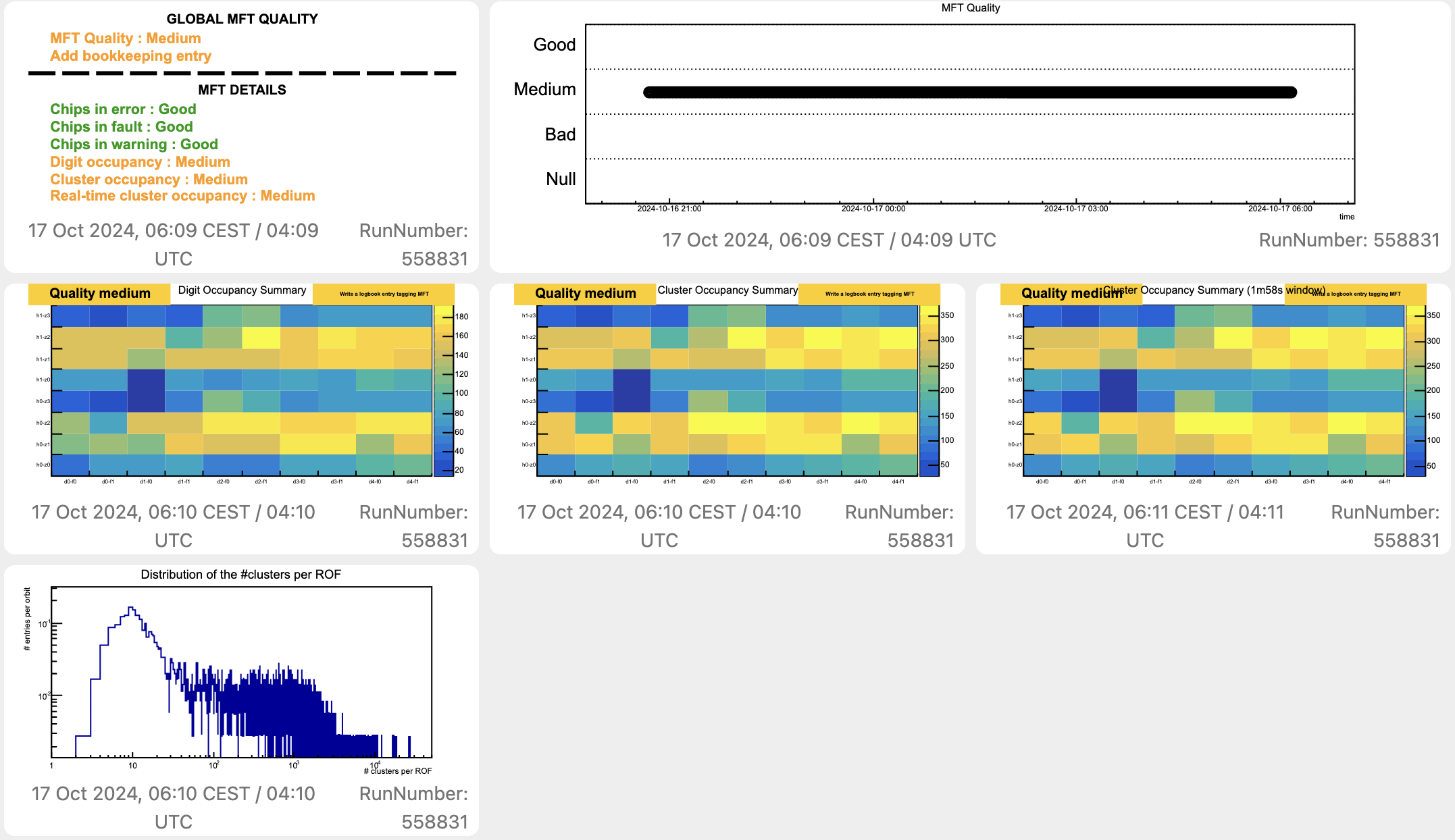
Expected output for REPLAY PbPb#
Readout Config URI: file:///local/replay/2024-02-07-pbpb-50khz-replay-LHC23zzk-544490/readout-replay-24g.cfg
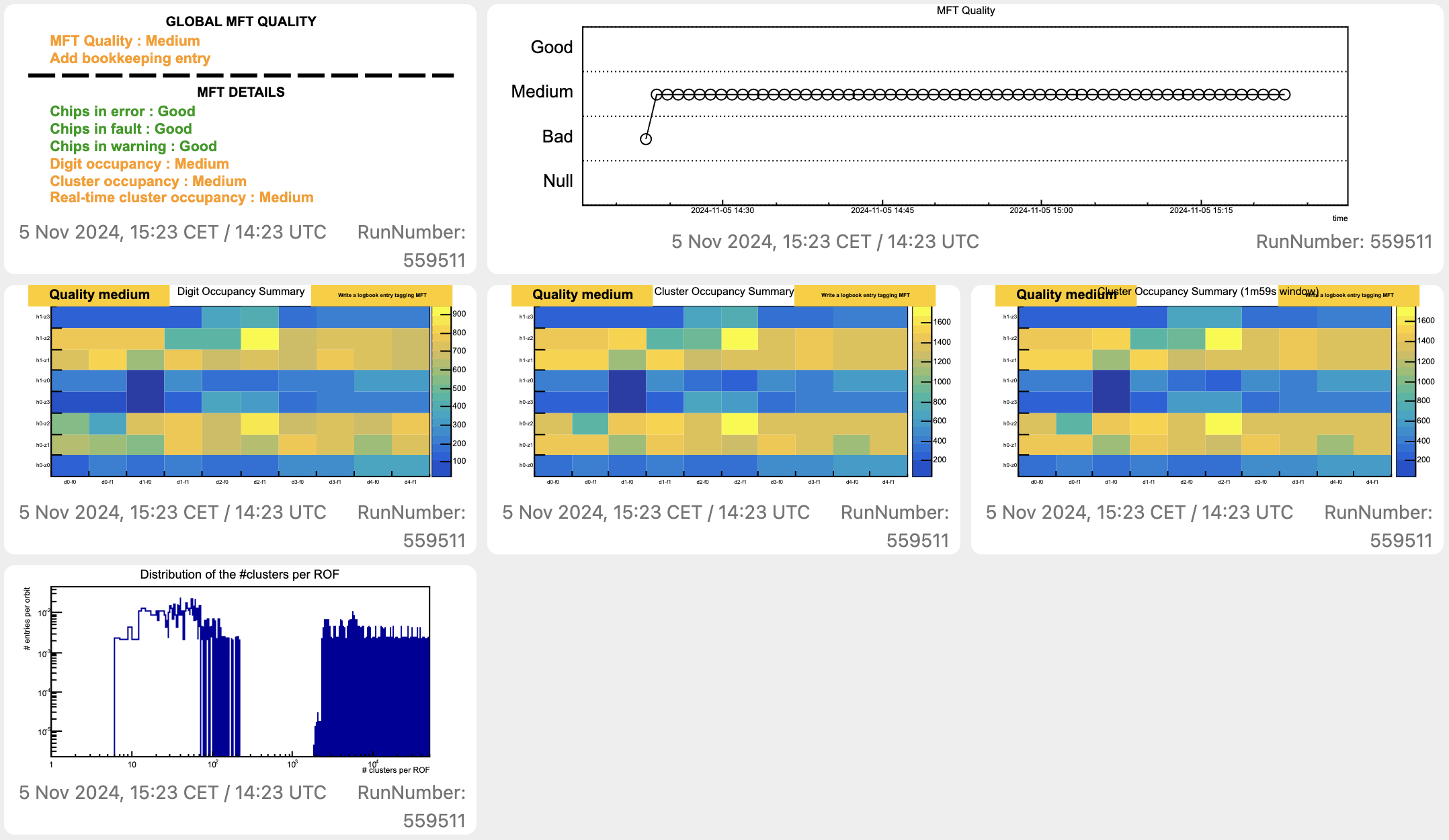
Known issues#
None
MID#
Local boards occupancy map (DigitsQC)#
[QC on EPN]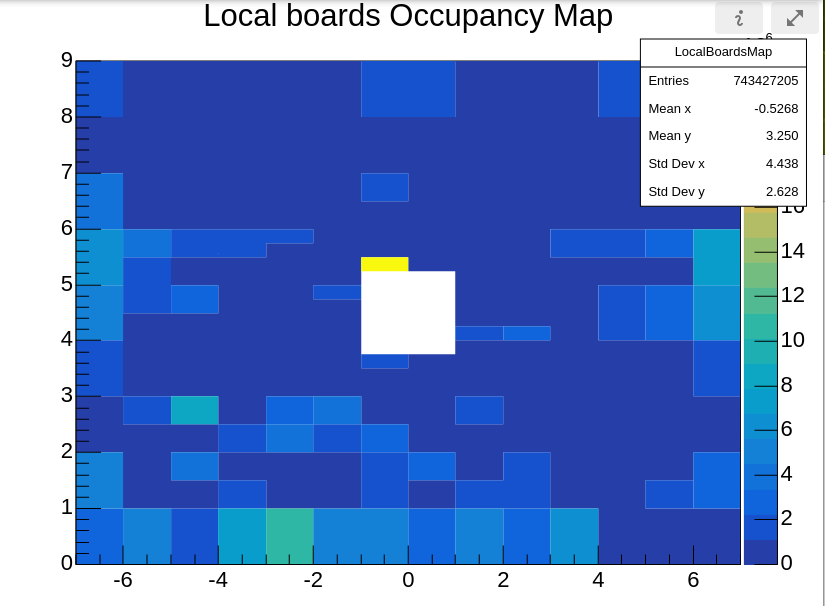
The plot shows fired local Boards.
Check just that plots are there and that they are filled.
** Notify the expert via mattermost and/or email ONLY in case there are no plots or completely empty plots **
Hits multiplicity (DigitsQC)#
[QC on EPN]
These plots show hits multiplicity by plane for bending and non-bending
-
if mean value > 100.
call expert
Known issues#
- MID has some empty bins in SYNTETHIC runs on "Local boards Occupancy Map" plot. Ignore them till it will be fixed
PHS#
Monitor if plots are not empty and timestamps are updated.
Ignore any red messages except "Number of entries has not changed in the past cycle".
If you see "Number of entries has not changed in the past cycle" but run is still ongoing inform the oncall.
[QC on EPN] Cell occupancy#

- The plot shows cell occupancy map in all 4 modules
- Note that because of a very little statistics replayed in synthetic runs, PHS occupancy is rather sparse.
- In case if plots are empty call the PHS on-call
[QC on EPN] Errors occurance#

- The plot shows decoder error occurance per event.
- For synthetic runs no decoder errors are expected. If plot is not empty please inform the PHS on-call.
- Please note that "Ok" message is false in case when there are enrties.
Bad example: errors present
Bad example: errors present but message is "Ok"
Minimal duration after SOR before taking any action required by these instructions: 5 min
Known issues#
- COSMIC, TECHNICAL, PHYSICS_PP runs Cell HG occupancy, mod[1-4]: white horizontal stripes can be seen which differs from the reference plots. QC shifter can ignore these patterns, because they are caused by dynamic FEE mask which is changed by the PHOS experts without prior notice. Only completely empty plots should be reported by the QC shifter to PHOS/CPV on-call
- COSMIC, TECHNICAL, PHYSICS_PP runs Cell HG occupancy, mod1 shows missing data in the area x=(32,47);z=(0,27) since end of March 2023. This is a known issue and is being investigated by PHS experts. No need to report it in the QC EOS reports and no calls to PHS/CPV shifters are needed.
- COSMIC, TECHNICAL, PHYSICS_PP runs. Sometimes QC shifters report on the error message in EPN infoLogger: Trailer decoding error: Last RCU trailer word not found. These errors are persistent, they appear in all COSMIC, TECHNICAL, PHYSICS runs since the beginning of Run3, and caused by a bug in SRU firmware. All these errors should be ignored.
TOF#
Ignore alarms if TOF is not READY
Important: This plot will not update during synthethic replay data runs.
Readout map (Slot Participating)#
[QC on FLP - plot integrated over the run]
| Green panel: good quality | Red panel: bad quality |
|---|---|
 |
 |
The plot shows a map of TOF readout slots per crate. The checker controls if enough crates are in the readout, if it detects lower than expected the quality is set to BAD. In case of red allarm please call TOF oncall.
Known issues#
Slot Participating will not update in REPLAY Runs, this is a known issue do not call the oncall.
TPC#
TPC SYNTHETIC#
Quality Observer / Number of Clusters / Quality Trending#
[QC on EPN]
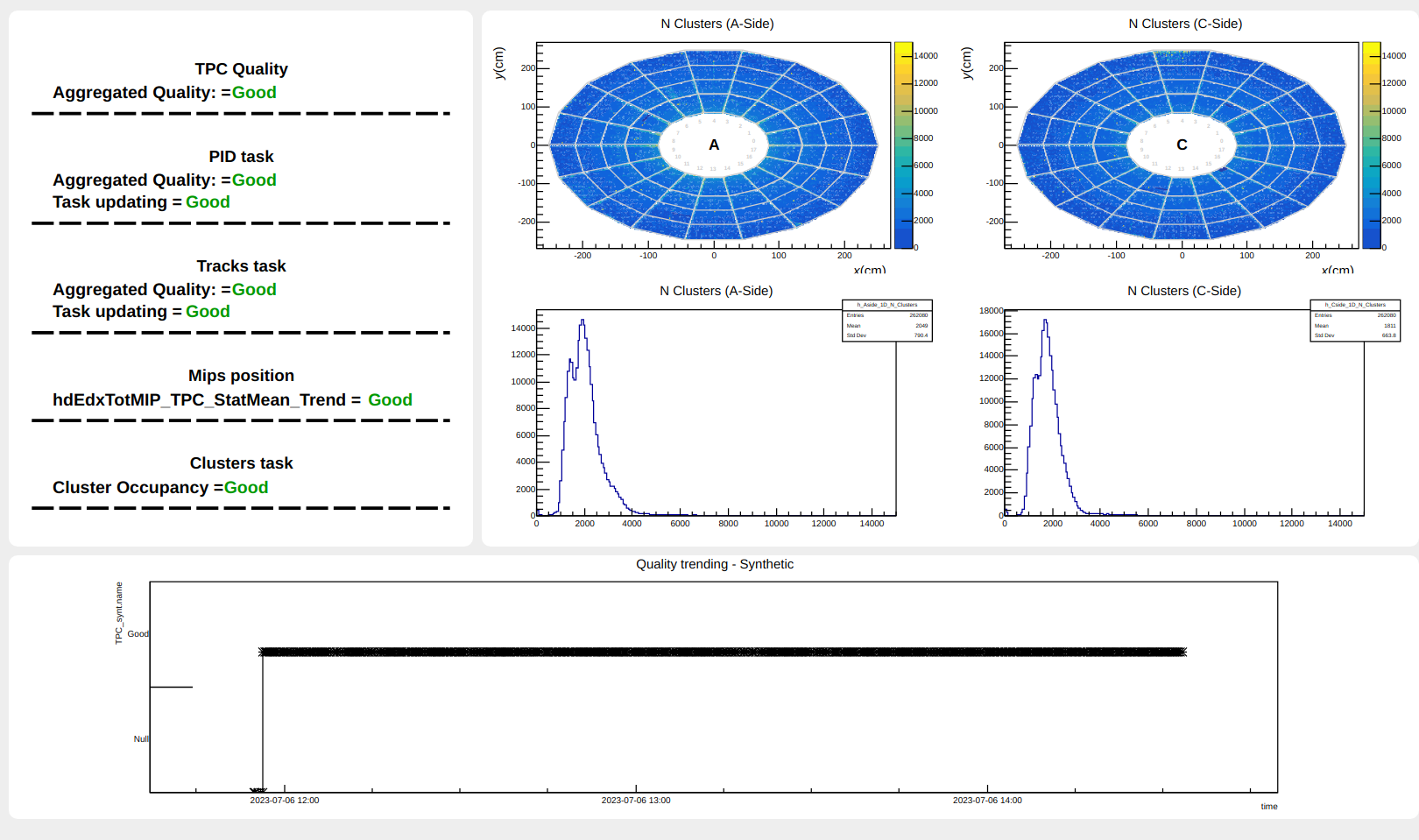
To be checked:
-
The time stamp at the bottom should update every two 2 minutes during running.
-
When run is ongoing all Qualities in the list should be GOOD after 3 update cycles (6 minutes). In case of a BAD quality put log entry.
-
If in the quality trending, the quality is constantly BAD for multiple cycles (>10 minutes) call On-Call.
-
In case the Cluster task quality is BAD you can check if there are holes in the N cluster plots and inform OnCall.
-
If Only PID quality is BAD check if dEdx calculation is activated. If this is not the case the PID quality can be ignored. For the dEdx following parameter has to be in the EPN Extra ENV WORKFLOW_EXTRA_PROCESSING_STEPS=\"TPC_DEDX\" . This is typically diabled for PbPb running
- For 1 MHz replay data the holes shown in the plot below are expected:
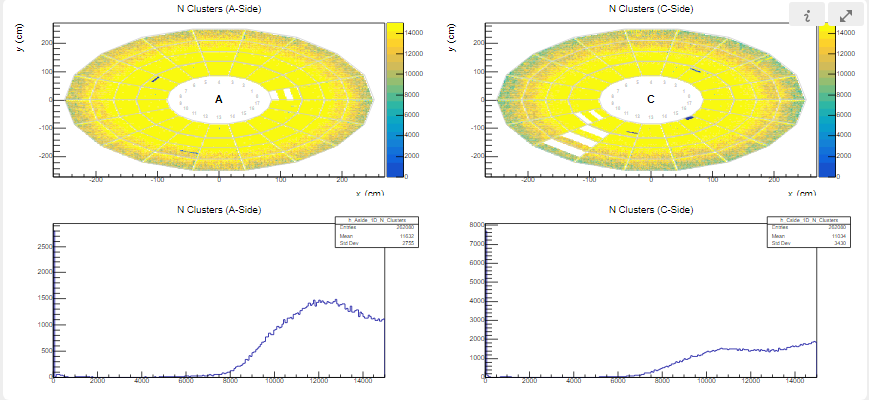
Known issues#
Occasionally, the 'Calib' QO may go red; this is an issue with the interplay of the validity of two objects. Please ignore if this behaviour is not persistent (work in progress).
TRD#
Layout for synthetic runs#
Note:
- all QC tasks for TRD are running on the EPNs
Data size per sector#
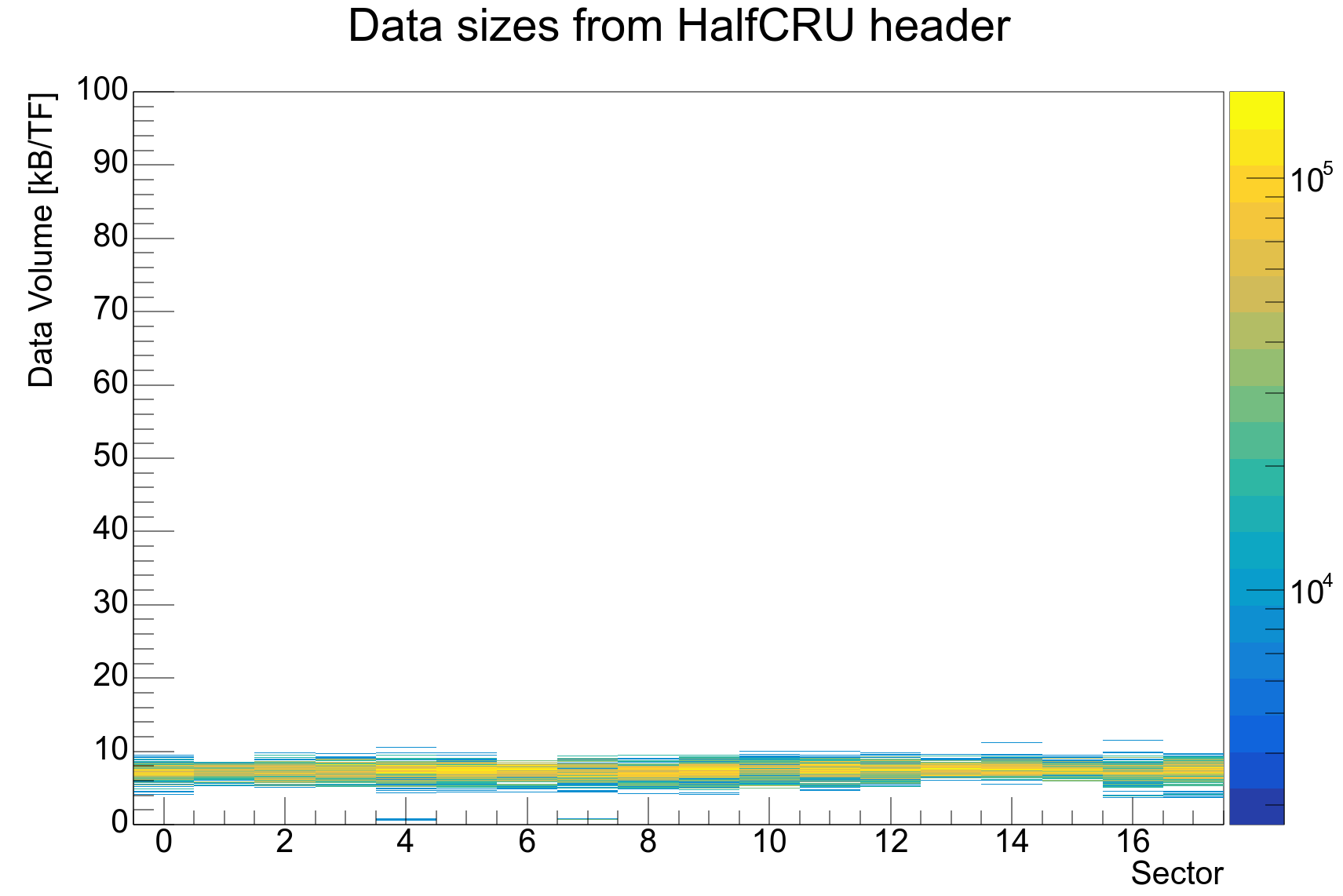
The TRD has 18 sectors which should all produce a similar data size per TF. In case on sector is deviating a lot (its mean is more/less than factor 3 from the rest) please write a bookkeeping entry tagging TRD.
Tracklet distribution in half-chambers#

This plot shows the number of tracklets per half-chamber. The x-axis is the sector number. If you see one column completely empty please notify the TRD oncall.
The crosses on the plot are from a static half-chamber status map which needs to be replaced by a dynamic one to correctly cross out half-chambers where no data is expected because of hardware issues.
Eta-phi distribution of ITS-TPC-TRD tracks#
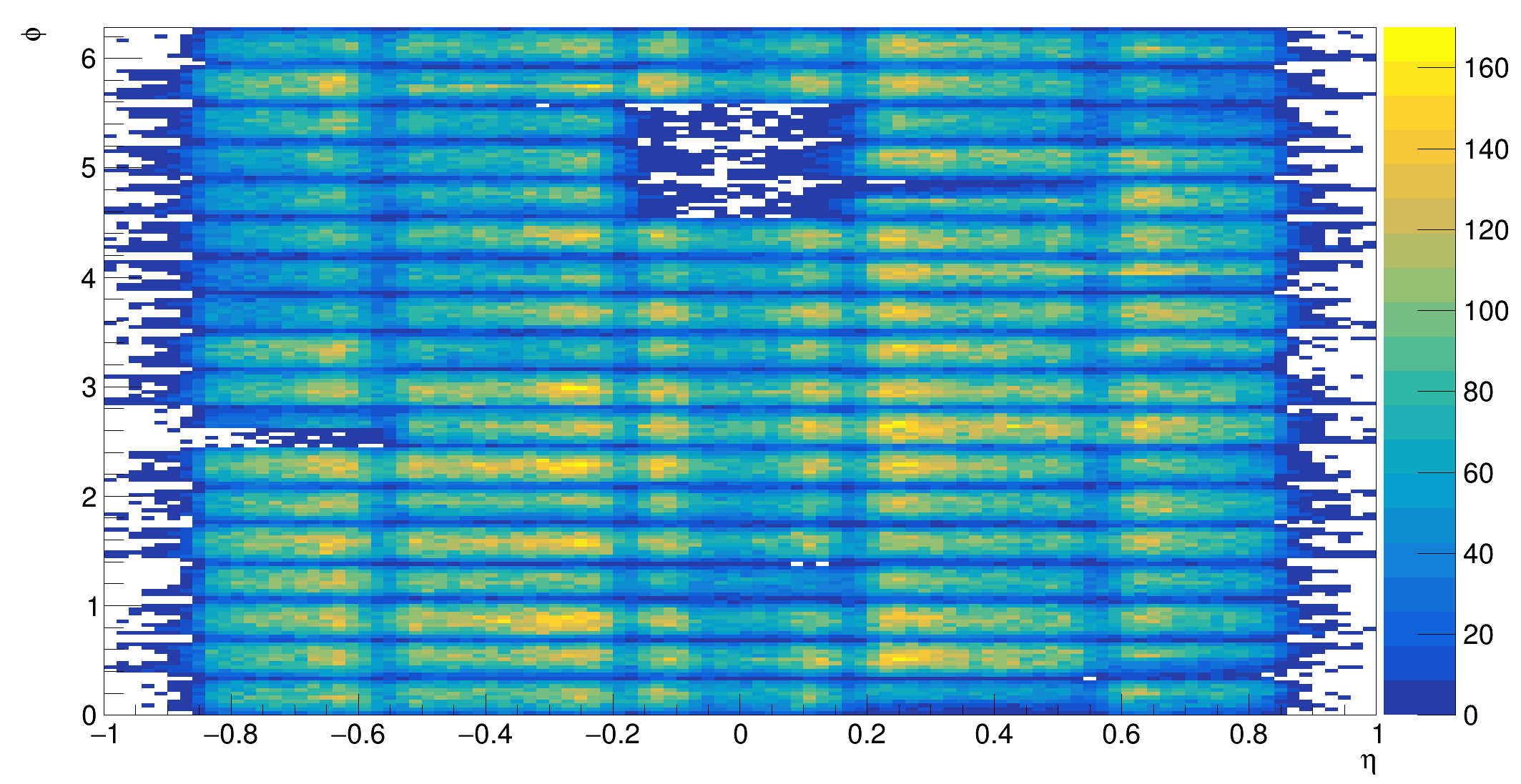
This plot will be empty if either ITS or TPC is missing in the run. This is expected and not a problem.
Eta-phi distribution for ITS-TPC tracks matched to at least 3 TRD tracklets. The PHOS-hole from abs(eta) < 0.2 and phi ~ 5 leads to almost no tracks in that region. For synthetic runs this plot is expected to be filled very sparsly. No need to contact TRD expert in that case.
Number of tracklets per event and TF#
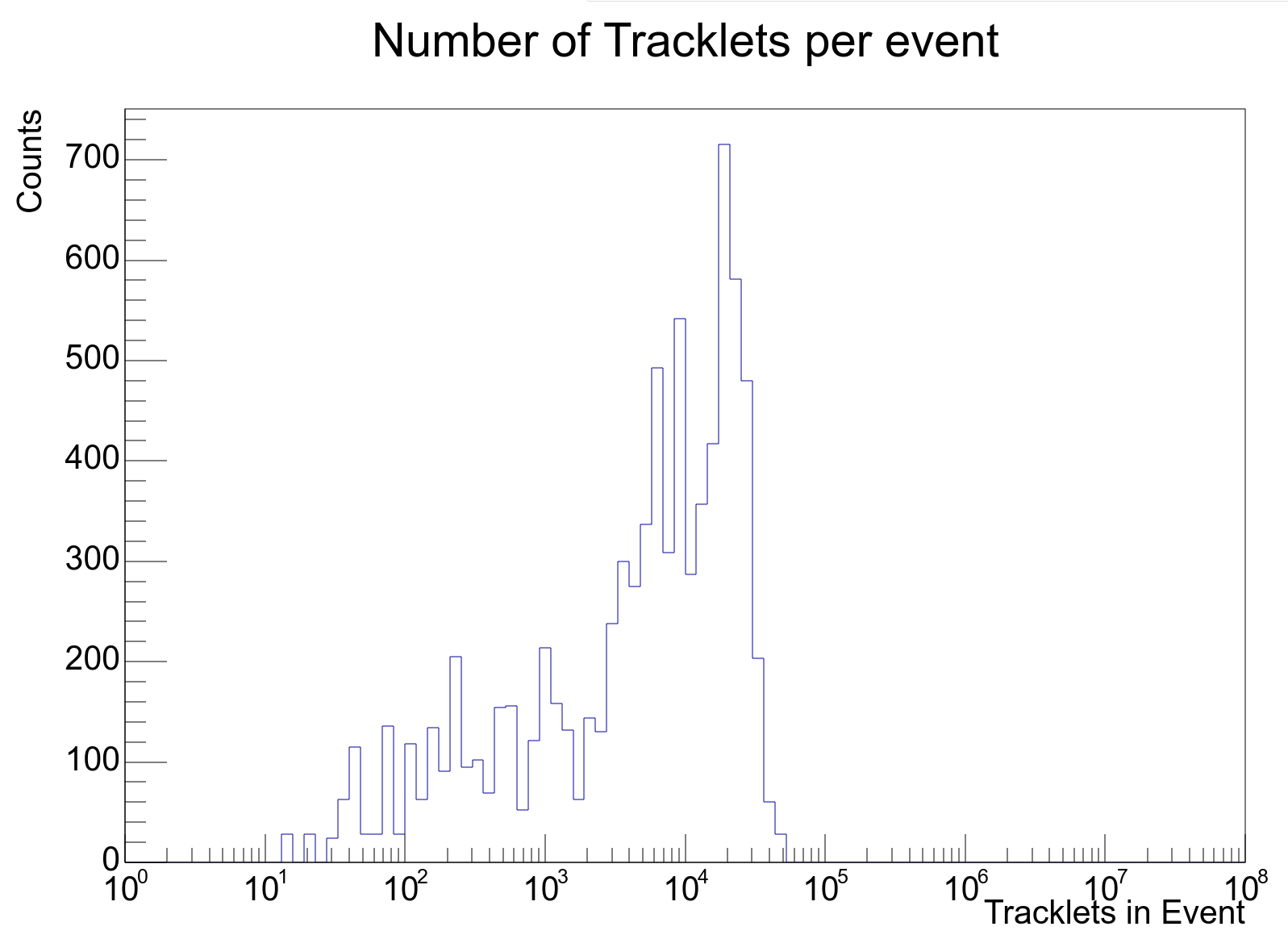

We would like to be notified via bookkeeping entry in case either more than one distinct peaks are appearing in the distributions or in case there are entries in the underflow bin in either of the two histograms.
Raw data statistics#

This plots summarizes statistics on the raw data, such as the number of collected timeframes nTF, the number of triggers nTrig the number of calibration triggers nCalTrig, the number of tracklets nTrkklts and the number of digits nDigits. Furthermore, the readout rate and the calibration trigger rate are determined from the collected data and shown in the plot. Please note that it is normal that the readout rate is lower than the interaction rate due to TRD dead times. The oncall shall only be called in case the plot is not filled at all.
Known issues#
QC plots for COSMICS are not consistent with the documentation.
- For the "Data sizes from HalfCRU header" plot shows deviations due to noisy sectors (values around 2500). This issue can be ignored till documentation is up to date.
- For the "Number of Tracklets per timeframe" plot has a double peak structure in COSMICS and a lot of entries in the underflow bin (around 90% of tracklets). The experts have been notified. The relevant log can be found here: https://ali-bookkeeping.cern.ch/?page=log-detail&id=80122. The issue may be fixed in future or the documentation updated.